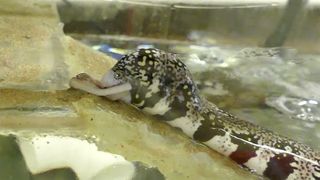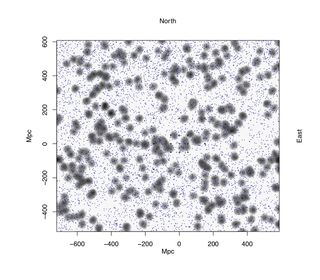No water? No problem
By Mindy Weisberger - Senior Writer 3 days ago

Moray eels have a second, hidden set of jaws that are the stuff of nightmares. These extra jaws can snap forward in an instant to clamp into prey and drag the animal down into the eel's gullet.
Those terrifying slingshot jaws help a type of moray do something that's impossible for most fish: swallow their prey while on land, according to a new study. It's an unnerving sight, with researchers' video showing prey being yanked down the eel's throat as the moray's mouth gapes open.
Fish typically need moving water to carry food from their mouths into their bellies. But snowflake moray eels (Echidna nebulosa) can ambush crabs on land by wriggling from the sea to catch their prey during low tide, and researchers recently found that the recoil of the eels' secondary jaws was strong enough to help morays swallow their meal without having to retreat back into the ocean.
All bony fishes — those with skeletons made mostly of bone, rather than cartilage — have pharyngeal jaws in addition to their main jaws. Pharyngeal jaws lie behind the pharynx, or throat. They are smaller than the jaws in fishes' mouths and are used for gripping and piercing or crushing food, according to the Smithsonian National Museum of Natural History.
But unlike most fishes' pharyngeal jaws, those in moray eels "are highly mobile" and can spring past the throat and into the morays' mouths, said Rita Mehta, an associate professor in the Department of Ecology and Evolutionary Biology at the University of California Santa Cruz (UCSC).
In 2007, Mehta described how moray eels took advantage of this extreme movement while feeding in the water, with their pharyngeal jaws acting as "these wonderful forceps that grab prey," she previously told Live Science. In the new study, published June 7 in the Journal of Experimental Biology, Mehta and co-author Kyle Donohoe, a research assistant at the UCSC Pinniped Cognition and Sensory Systems Laboratory, filmed eels as they munched on meals while out of the water, Mehta told Live Science in an email.
"Based on what we knew about the mechanics of the pharyngeal jaws, it made sense that if morays were able to capture prey in the intertidal or on land, they could also swallow their prey on the land without relying on water," Mehta said.

Long muscles pull morays' pharyngeal jaws forward to grasp prey and then slide it down their throats. (Image credit: Zina Deretsky, National Science Foundation (after Rita Mehta, UC Davis))
Training snowflake moray eels to feed out of water in lab experiments — and then recording the results — took six years, according to the study. The scientists installed eels in aquariums equipped with platforms and ramps that were above water. They then trained the eels — named Benjen, Marsh, Qani, Jetsom, Frosty, Flatsom and LB — to climb up the ramps for pieces of squid. Over time, the food was moved higher up the ramp, until eventually the eels were independently wriggling out of the water and undulating up the ramps to find food.
"For the majority of terrestrial trials, snowflake morays undulated the upper third of their body from the water to capture prey on the ramp," the researchers reported. They analyzed 67 videos of eels' meals in water and on the ramp, finding that the fish used their pharyngeal jaws in the same way and at the same speed while in water or on land.
Morays aren't your average "fish out of water." They can function during temporary oxygen deprivation, and studies of a snowflake moray relative, the Mediterranean moray (Muraena helena), showed that lipids and mucus in morays' skin could protect the eels against drying out when they're exposed to air, the study authors wrote.
The experiments offered previously unseen examples of moray eel behavior, hinting at how morays might combine amphibious traits with a slingshot jaw to make them versatile and formidable hunters in wet or dry environments. These adaptations could allow morays to find new types of food if their regular supply disappears and may help the fish avoid competition in their ocean ecosystems by letting them feed in a different habitat, Mehta said.
The findings were published on June 7 in the Journal of Experimental Biology.
Originally published on Live Science.
















